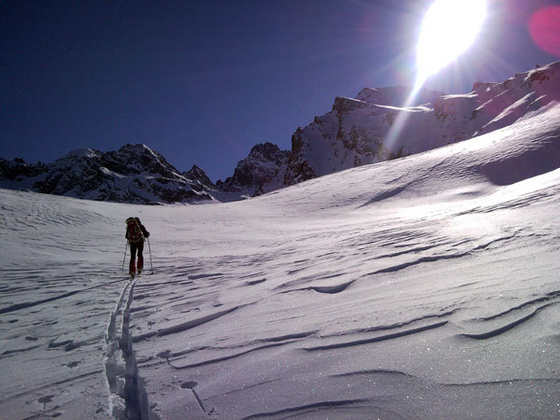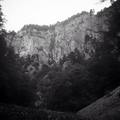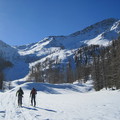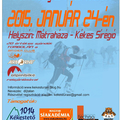Ahogy mondani szoktam: harminc felett minden nap ajándék.
Jean-René Minelli 2004-es expedíciójáról készült videó némi betekintést nyújt:
IN THE FOOTSTEPS OF WILD ANIMALS
Paolo Rabbia interview by Vinicio Stefanello
Paolo, all the Alps in 62 days: is what you did something for madmen or dreamers? Or is it simply because no one had ever done this in winter before that you embarked on this great journey?
On the last day, as I looked across the Alps, I didn't think "yes I've done it". Instead I thought: how could I have done this? It's crazy! It's true that when the idea began to take shape, I was motivated by being the first. Having said that, isn't this how new routes are climbed in the mountains?
How did you train for the traverse?
Just as for expeditions in the Himalaya. A lot of aerobic work out, on foot and by bicycle, plus a bit of pre-skiing.
What goals did you set yourself, what "rules" to play by if you had any?
I decided right from the outset that there had to be a few rules only, but that these had to be very clear indeed: I wnated to carry it out all on my own, even if this meant truding along the bottom of the valley. This caused some misunderstandings when I asked for information about how best to continue, because almost everyone thought it obvious that I'd take a bus as soon as I'd taken my skis off. Luckily I never had any problems when I crossed pistes, despite the difficulties that ski mountaineers have when they use pistes for training. I was never hindered, on the contrary, I'd say that I was always treated kindly. I never had a ticket for the lifts, so I just did without.
How did you choose your route and did you modify it as you proceeded?
I had the report of the Bonatti expedition and I used this wherever possible. The route I followed in the Julian Alps and the Carnia was practically the same, while in the South Tyrol I didn't even attempt Cima Grande di Lavaredo, Bonatti and Longo's first ascent. At Brunico, instead of ascending up into Valle Aurino where incredibly I had been told there was too little snow, I continued straight towards Val Passiria, where I joined up with the 1956 route once again. I came across good conditions and managed a slight variation to the summit of Similaun, but unlike Bonatti I didn't reach the summit of Ortles. When I reached Bivio, in Grigioni, I opted against going to the lower valley where nowadays the motorway runs and instead ascended the upper valley, past Saint Gotthard to return to Airolo. I followed Bonatti's tracks to Alpe Devero, was then unable to reach Saas Fee via the Zwischenberg Pass (3434m) and so continued to Sempione and the Zermatt valley. A short two hour break at Passo del Theodulo allowed me to ascend quickly to the summit of Breithorn, at least that way I ascended one 4000m peak. Bad weather followed me from there on all the way to France and not only did I not ascend Mont Blanc, during the entire period when I was in that range I never even caught sight of it. From there my route continued to Monviso and then I reached Valle Stura, lengthening the itinerary slightly to enjoy Valle Maira, where as a child I skinned for the first time. On day 60 I reached Colle di Nava and since I didn't want to finish my route on a tarmacked road, I added another couple of days and finished on the pistes of Garessio 2000, skis firmly strapped to my feet.
Let's talk about your gear. How did you choose it and above all how heavy was your rucksack. And how did you organise logistics, where to sleep, eat etc?
Ever since I did some climbing in the Himalaya I've been lucky to have a partner which isn't a famous company but instead the local mountaineering shop. I spent two months testing different gear and in the end I chose the equipment which guaranteed comfort before anything else. My boots weren't the same as you get over the counter, but I was willing to exchange precision for comfort: in two months I never got a single blister. The skis weren't the lightest on the market, but when you descend on ice or crust with a 16kg pack it's important that they don't play nasty tricks on you. Obviously I don't want to mention the names of the gear companies, but what I can say is that the equipment I used really does work, and for extended periods of use. I had only the absolutely necessary in my rucksack: some clothes, a satellite telephone, a headtorch. some medicine, a shovel, sleeping bag and bivvy bag, thermal blanket, gas stove and some food and integrators. Thankfully I bivvied only three times. The Alps aren't the Himalaya and despite the migration away from the peaks there are still some courageous people who still run their parent's lodgings. There are also some winter shelters and in some lucky cases I was a guest of guides of people working for the mountain rescue service.
Difficulties: what were the difficulties and risks in an adventure such as this one? As things turned out, this happened to be a "special" winter... how did things go with the avalanche danger?
As you said, this year was a bit abnormal. Just think, apart from my friends who joined up with me, during the first 45 days I only met two other ski mountaineers. The weather forecast always discouraged people from getting out. And in some areas the local council had even forbidden ski mountaineering. Seeing that every now and then there were some articles in the press, I avoided saying anything so as not to worry my relatives at home. But apart from the first twenty days, the situation was serious.
You spent a couple of days with two friends, Luca Vuerich and Diego Giovannini, but apart from this you traversed entirely on your own. What was your solitary day like?
I was on my own for ony 45 days, because I was accompanied by some members of the Moutnain Rescue squad, the Guardia di Finanza and some good friends of mine, especially when I got closer to home. My typical day was as monotonous as you can imagine: I was out at first light and continued until sunset. Monotonous, but also not very relaxing, as I was always worried about which route to take and often my eyes were fixed on the slopes and all the snow above me.
And at night?
As soon as I arrived I fell asleep, exhausted. But I was awake again well before dawn, pensive, very nervous but thankfully also in high spirits.
What does one meet in the middle of the Alps in winter? What struck you most?
At La Fouly, in Switzerland's Val Ferret I spent an unforgettable evening with Jean Troillet whom I had met years back on Gasherbrum. He's well over 60 years old and he continued to tell me about next season's Himalayan projects with contagious enthusiasm. And then there was a great evening in a restaurant in Chialvetta, located in Valle Maira, with Clemente Berardo, a mountain Guide from Monviso. He's over 70 years old and at a certain point he turned to me and said "tell me, have you noticed how after a while you always end up following the paths taken by the wild animals?" And he was right.
In what way?
Just like everyone else who seeks adventure I set off with my GPS, but as the days progressed I realised that I was using it less and less, until one day I got rid of it altogether. Slowly but surely I stopped glancing at the map every quarter of an hour and I then began to trust my instinct more and more. Both in the forest and on open slopes I realised that the best and most prudent route was always the one taken by the legitimate owners of nature: the animals. And like them I decided to be one with the mountain, without leaving any other trace except for my ski tracks.
What was the most curious thing that happened to you during the traverse?
On 12 February I passed Val d'Isère, right during the ski world championship, and I was welcomed into the Italian booth by some of the most important Italian skiers. It was a really fun situation. On the one hand I felt honoured to be considered at the same level as the athletes, on the other I gave the impression of being a real vagabond, with a long beard and truly famished.
And the most beautiful moment?
The arrival at Garessio, without a doubt. At a certain point during the final descent, a bit like during the final stage of the Tour de France, I was joined by "gregarious skiers" who offered me a glass of champagne. And then there were all those people at the "finishing line"...
What difficult moments did you encounter? Did you ever think about giving up?
The worst day ever was on Saint Gotthard: the weather was bad, but up to then I had never stopped so I set off nevertheless. I was hit full on by the storm, it was really bad. The wind blew me over twice and I simply couldn't see anything. I dived into a tunnel and since the weather wasn't getting any better I decided to turn back, but my tracks had already disappeared. I never thought about giving up, but had something irrepairable happened then I wouldn't have been too amazed. I always thought that I probably wouldn't complete the traverse, right up to the very end. It was only a matter of luck.
This question is begging to be asked: what impressed you most of the Alps, seen on a daily basis and in their entirety? And how healthy were there?
Seen from above, especially covered in such exceptional snow, the Alps are truly majestic. But it's difficult to pan around completely and not find something which mortifies them. There's no point deceiving oneself: the Alps will never again be an area of true wilderness, they are besieged by urbanisation and the expansion of communication lines. This doesn't mean though that you cannot savour priceless moments alone, but it's one thing being in a virgin forest, and another in a botanical garden.
You obviously crossed areas you didn't yet know. What mountains amazed you most?
For those who like me live in NW Italy, I'd definitely recommend a trip to the Julian Alps. Apart from the lack of crowds, the local inhabitants are genuinely cordial. Another nice discovery was Val Formazza, where the slopes are ideal. For pure and simple ski mountaineering nothing beats the southern Alps, both in France and the Cuneo area.
I imagine that you measured the height gain and total descent... If you could sum it up, what did all this ascending and descending give you?
First of all I set off to go on a journey. In the end, if you bear in mind the almost 1800km, 150,000 height gain and loss, 62 days on the trot with only two rest days, then I reckon it was also a fairly good sports performance. The present which this traverse gave me was managing to complete it.
After 62 days and 1800km with skis strapped to your feet... how do you now manage to get back into the rhythm of everyday life?
By simply making the effort to render it special. www.planetmountain.com






